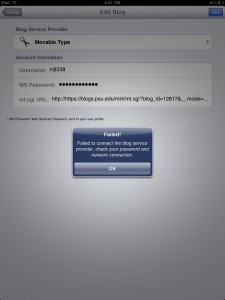Yesterday in class, we tried to set up our BlogPress apps for our Blogs at PSU blogs so that students could use the app to post to their blogs. I’ve been using BlogPress for about a month to post to the course blog and to our iPad study blog, and while the app has some limitations, it’s really a rather nice way to post to a Movable Type blog. In fact, it’s really the only option on the iPad besides posting through your dashboard on Safari. However, evidently the most recent update of the app inserted a bug in the code, so that when you enter the mt.cgi URL to set up your blog, the app auto adds “http://” before the URL. This, of course, causes problems when the URL you entered starts with https://.
 I read the reviews of BlogPress on the app store, and saw one reviewer comment that the developer emailed back fairly quickly. So I went to BlogPress’s website and emailed, explaining my problem. The response was fairly quick, which was great, but failed to address the problem and suggested a solution irrelevant of the problem (something that would be clear I knew how to do, since I had mentioned that I used the app successfully in the past).
I read the reviews of BlogPress on the app store, and saw one reviewer comment that the developer emailed back fairly quickly. So I went to BlogPress’s website and emailed, explaining my problem. The response was fairly quick, which was great, but failed to address the problem and suggested a solution irrelevant of the problem (something that would be clear I knew how to do, since I had mentioned that I used the app successfully in the past).
I don’t mean to be nagging about this developer specifically—in fact, after another email, we cleared up the confusion and the developer said he would fix the bug (sometime?). But I think this raises questions about technical communication, as well as the integration of technology in classrooms. When I complained about this on Twitter, @baconred (Greg WIlson) replied with a few interesting points: large companies tend to devote resources and personel to customer services and technical communication, but smaller companies or individuals (those who are often creating apps for devices like the iPad and iPhone) might not have those resources or experience in technical communication or customer services. Greg also pointed out that often an app’s description on the app store is not clear, and users have to rely on reviews on the app store to figure out what the app does. I’ve often had to rely on blog posts elsewhere after googling an app to figure out what an app does and if I really want to download it.
Greg asks “If phone/pad aps are the future of software, wonder what that says about future of tech com?” A good question, I think. We often prepare students in our technical writing classes for work for businesses or organizations, not considering that they would be the business or developer themselves (or in a small group). I’m also considering what this means for using devices and apps in the classroom. In the past, when teachers “incorporate technology” (admitting that we are always incorporating technology in the classroom), it meant fairly stable software and hardware. A laptop’s or computer classroom’s software was fairly stable — perhaps a few remote updates, but generally not much changed. But now, our software can be updated to the point of annoyance (I read a good blog post recently about this issue, but can’t find it). And with those updates sometimes come new bugs and problems (to the point that, if BlogPress doesn’t update soon to fix this problem, we have a useless $2.99 app on 35 ipads). These new trends in software development and communication certain offer interesting scenarios and raise questions about how communication, software, and classrooms will be working.
CREDIT: blog post title from Greg’s tweet.

